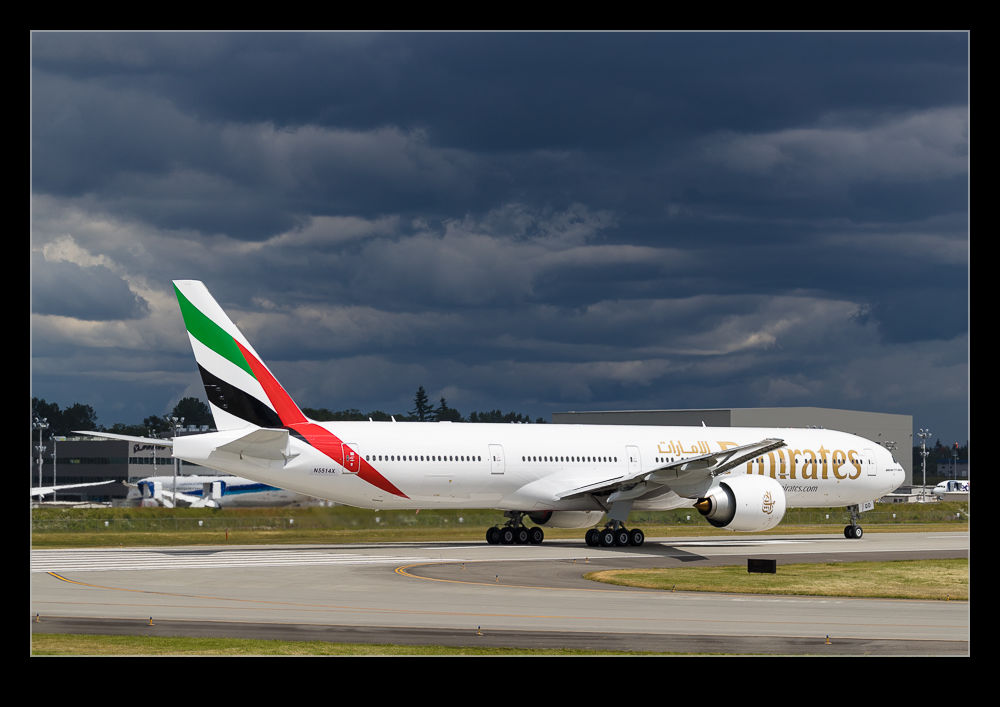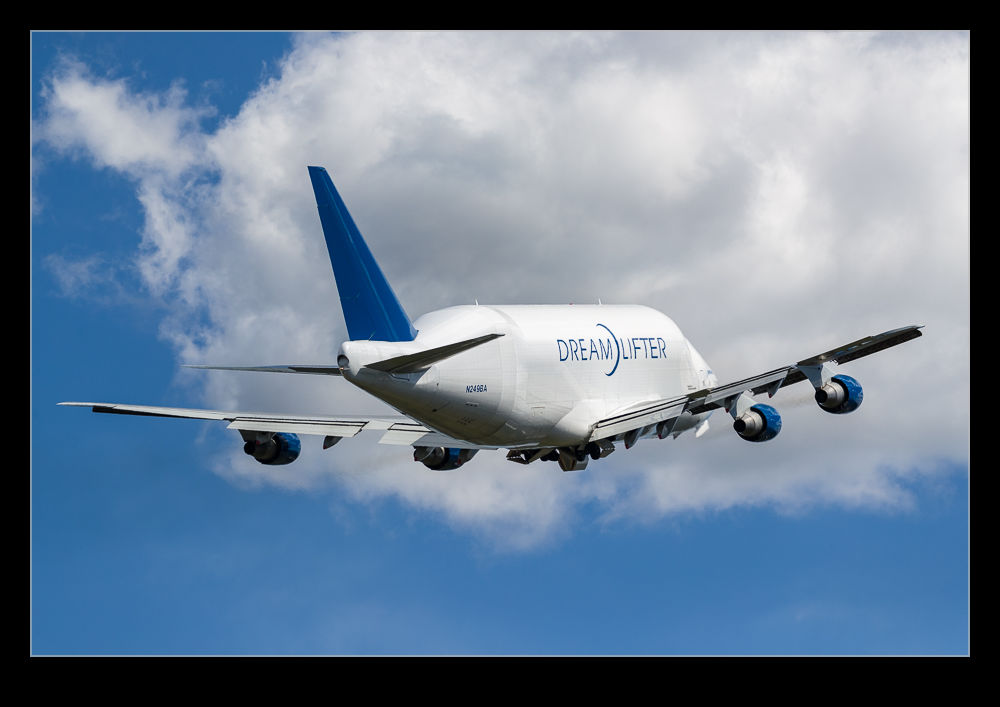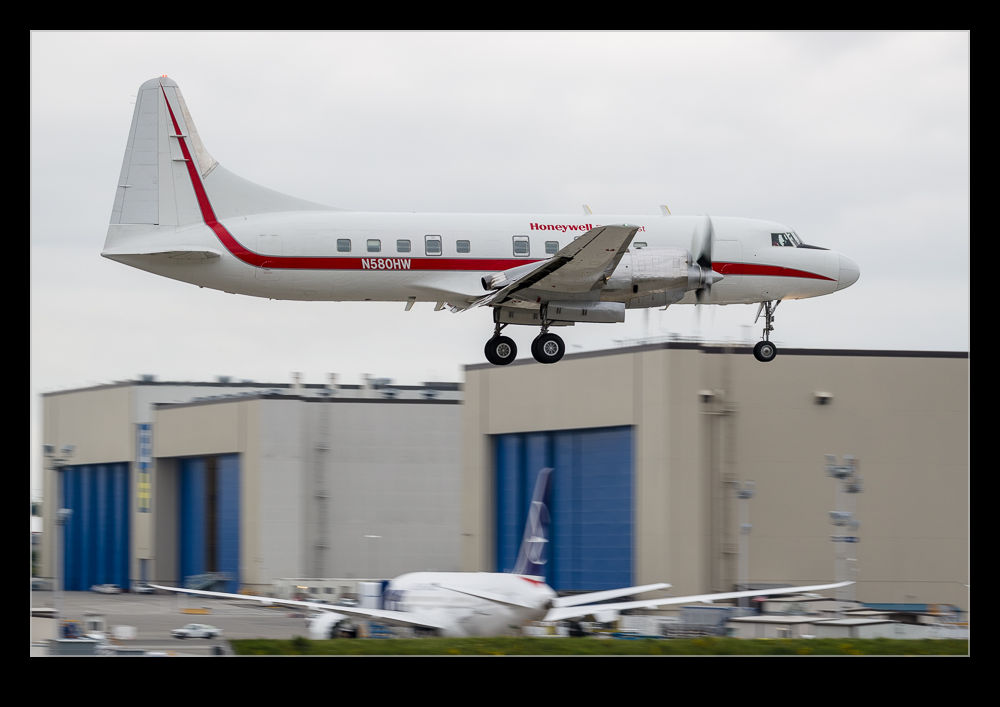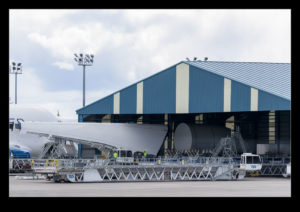 An Emirates 777-300ER is hardly a rarity. They have a huge fleet of them and, since this one is a new build aircraft on test at Boeing, the fleet is going to grow. What made this one fun was the light. Some stormy weather had been in the area and the sun was out on the white fuselage while the background was still looking rather mean. Both on the runway and on the approach, it shone brightly against the background and that is why I am sharing it today.
An Emirates 777-300ER is hardly a rarity. They have a huge fleet of them and, since this one is a new build aircraft on test at Boeing, the fleet is going to grow. What made this one fun was the light. Some stormy weather had been in the area and the sun was out on the white fuselage while the background was still looking rather mean. Both on the runway and on the approach, it shone brightly against the background and that is why I am sharing it today.
Tag Archives: airliner
Max Development and Production Jets
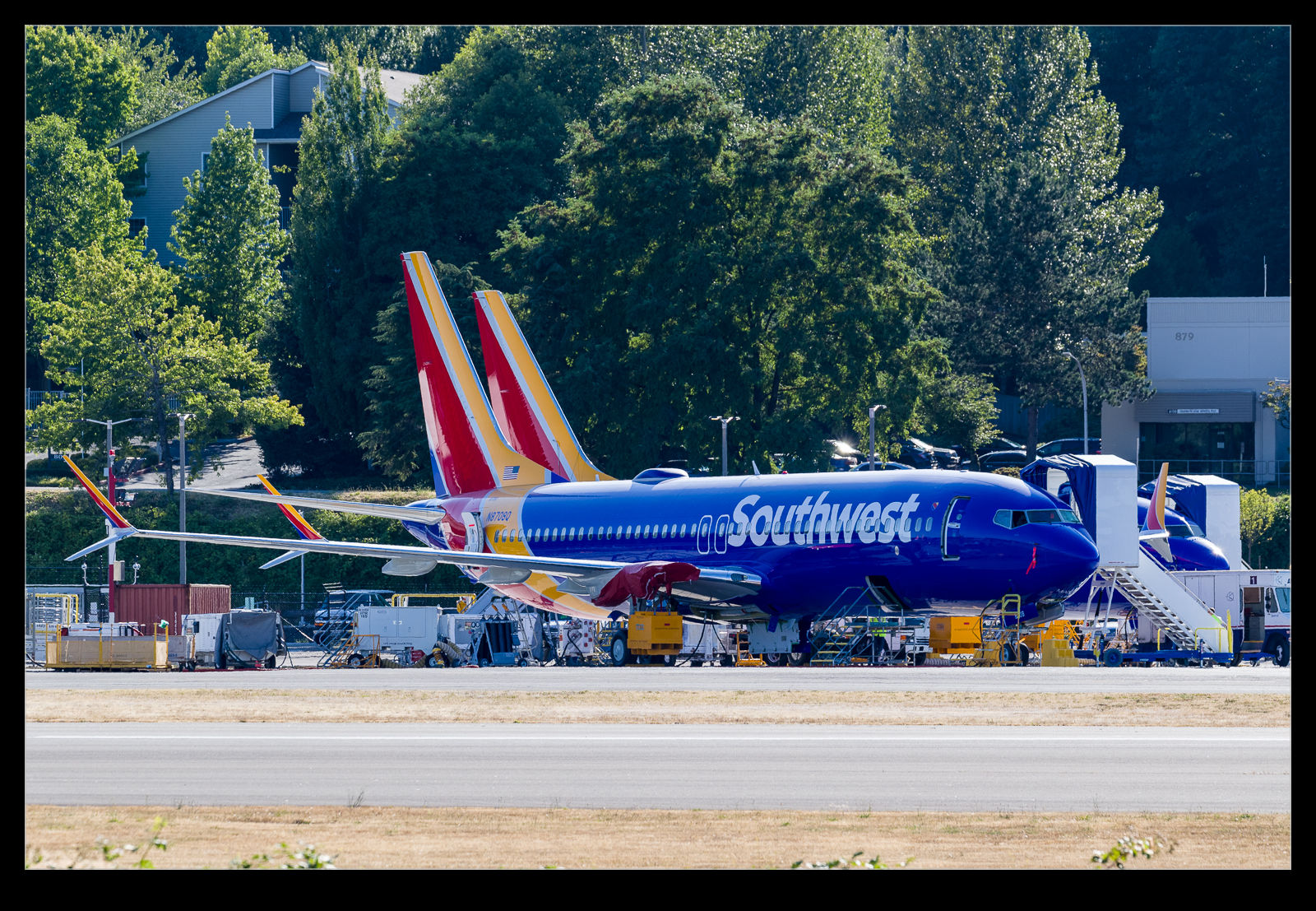 Boeing has completed flight testing of the first version of the 737 Max family, the Max 8. The Max 9 is currently in flight test and I posted shots of one of those aircraft here. While some additional flight testing will be carried out on the Max 8, the test fleet is now done. In due course, these aircraft will be refurbished and sold on to customers. In the meantime, new production jets are being built for delivery – except when it comes to Southwest.
Boeing has completed flight testing of the first version of the 737 Max family, the Max 8. The Max 9 is currently in flight test and I posted shots of one of those aircraft here. While some additional flight testing will be carried out on the Max 8, the test fleet is now done. In due course, these aircraft will be refurbished and sold on to customers. In the meantime, new production jets are being built for delivery – except when it comes to Southwest.
 As a result of a crewing issue, Southwest is delaying taking its jets until they have removed the 737-300 fleet from service. Consequently, Boeing is building them but not delivering them. There are a number parked up in the parking lot at Boeing Field and some are still sitting at Renton. Engines aren’t fitted since this is one way to keep the cost down pending delivery. They will be fitted and flown nearer the delivery date.
As a result of a crewing issue, Southwest is delaying taking its jets until they have removed the 737-300 fleet from service. Consequently, Boeing is building them but not delivering them. There are a number parked up in the parking lot at Boeing Field and some are still sitting at Renton. Engines aren’t fitted since this is one way to keep the cost down pending delivery. They will be fitted and flown nearer the delivery date.
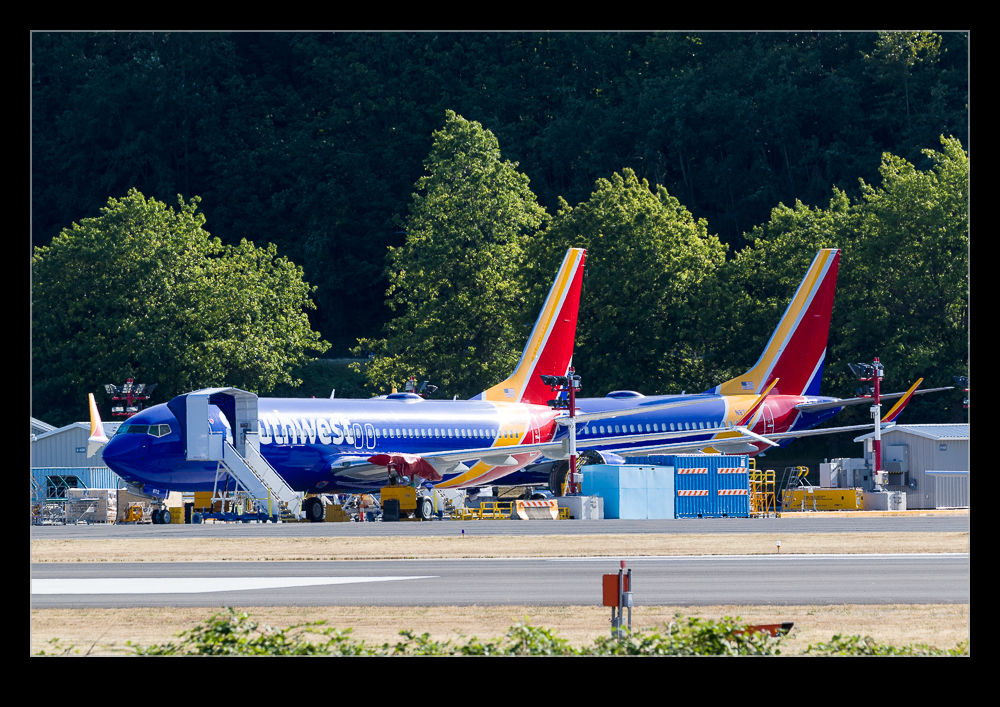 The flight line of these dormant Max 8s sits alongside the municipal part of the airport. I created a panorama of the jets which you can zoom and pan around below.
The flight line of these dormant Max 8s sits alongside the municipal part of the airport. I created a panorama of the jets which you can zoom and pan around below.
Dreamlifter Shape Explored
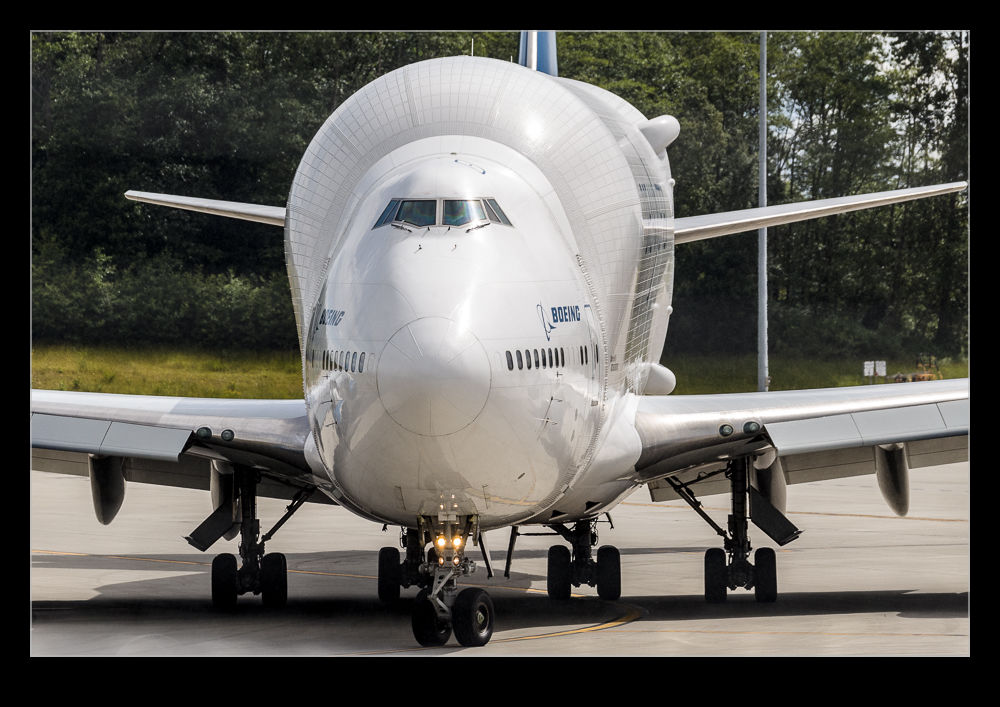 Since the Dreamlifters are a regular feature around this part of the world, catching a movement is not a big deal. That gives you a chance to think about shooting the planes in a different way. I have been interested in the shape of the structure and the texture it has. Since the Dreamlifters have been built to serve one purpose – that of moving bits of the 787s around the world – they are functional rather than elegant. The shape is designed to maximize the capacity.
Since the Dreamlifters are a regular feature around this part of the world, catching a movement is not a big deal. That gives you a chance to think about shooting the planes in a different way. I have been interested in the shape of the structure and the texture it has. Since the Dreamlifters have been built to serve one purpose – that of moving bits of the 787s around the world – they are functional rather than elegant. The shape is designed to maximize the capacity.
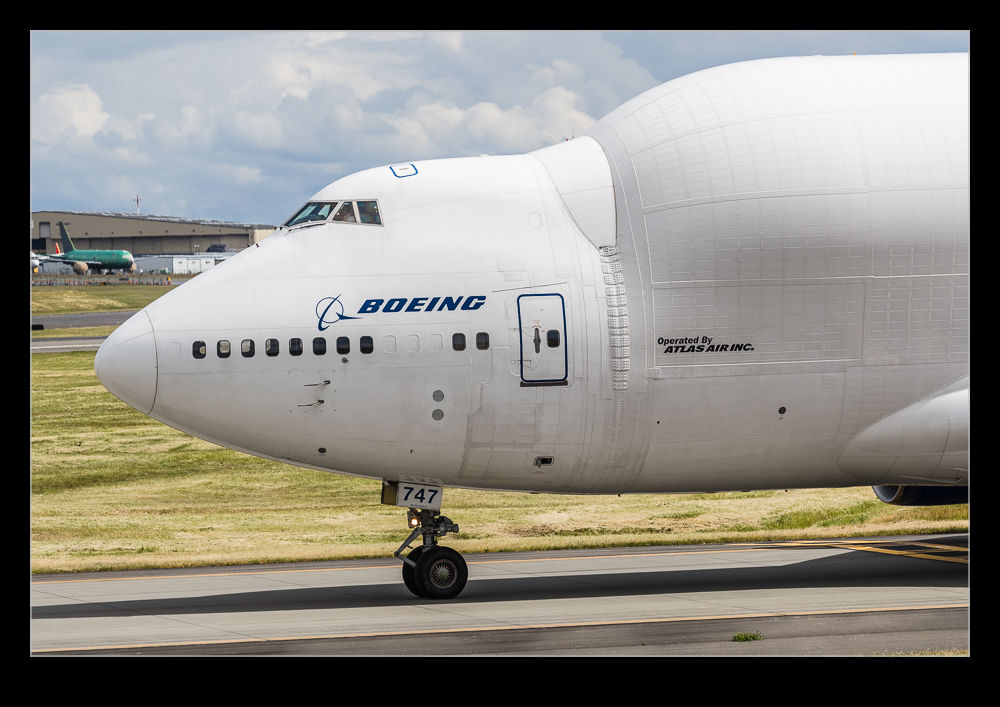 Meanwhile, the modifications have been made to a base airframe so some of the joints between the new structure and the original are pretty agricultural. The number of fasteners that are visible on the surface are substantial. This is not a problem. The plane serves a purpose and it does this well. The way in which the fuselage shape transitions from the original 747 lines into the Dreamlifter lines are also very interesting. A tighter shot gives you a good view of how the curves come together.
Meanwhile, the modifications have been made to a base airframe so some of the joints between the new structure and the original are pretty agricultural. The number of fasteners that are visible on the surface are substantial. This is not a problem. The plane serves a purpose and it does this well. The way in which the fuselage shape transitions from the original 747 lines into the Dreamlifter lines are also very interesting. A tighter shot gives you a good view of how the curves come together.
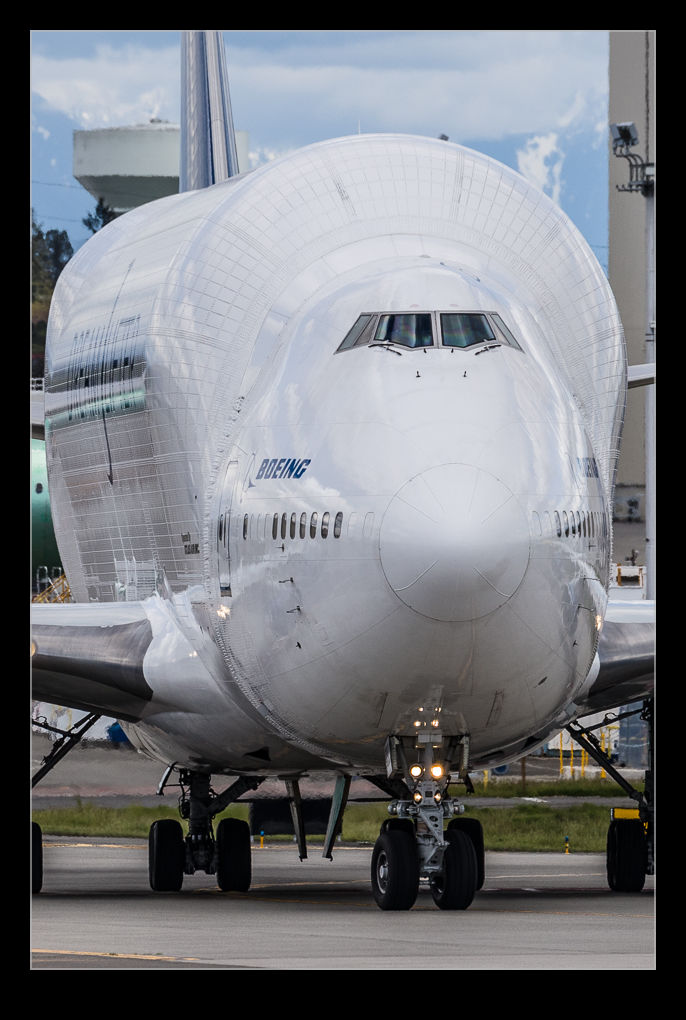 The Dreamlifter is not a beauty. I don’t even think it is as good looking as the Belugas that Airbus uses which have a more integrated feel to their design. However, it does the job well and it is nice to have a different shape in an era when every airliner is looking like every other. A bit of variety is a welcome thing and, while I am lucky to be close to them on a regular basis, I shall continue to appreciate what I get to see.
The Dreamlifter is not a beauty. I don’t even think it is as good looking as the Belugas that Airbus uses which have a more integrated feel to their design. However, it does the job well and it is nice to have a different shape in an era when every airliner is looking like every other. A bit of variety is a welcome thing and, while I am lucky to be close to them on a regular basis, I shall continue to appreciate what I get to see.
Departing Dreamlifter Finds the One Cloud
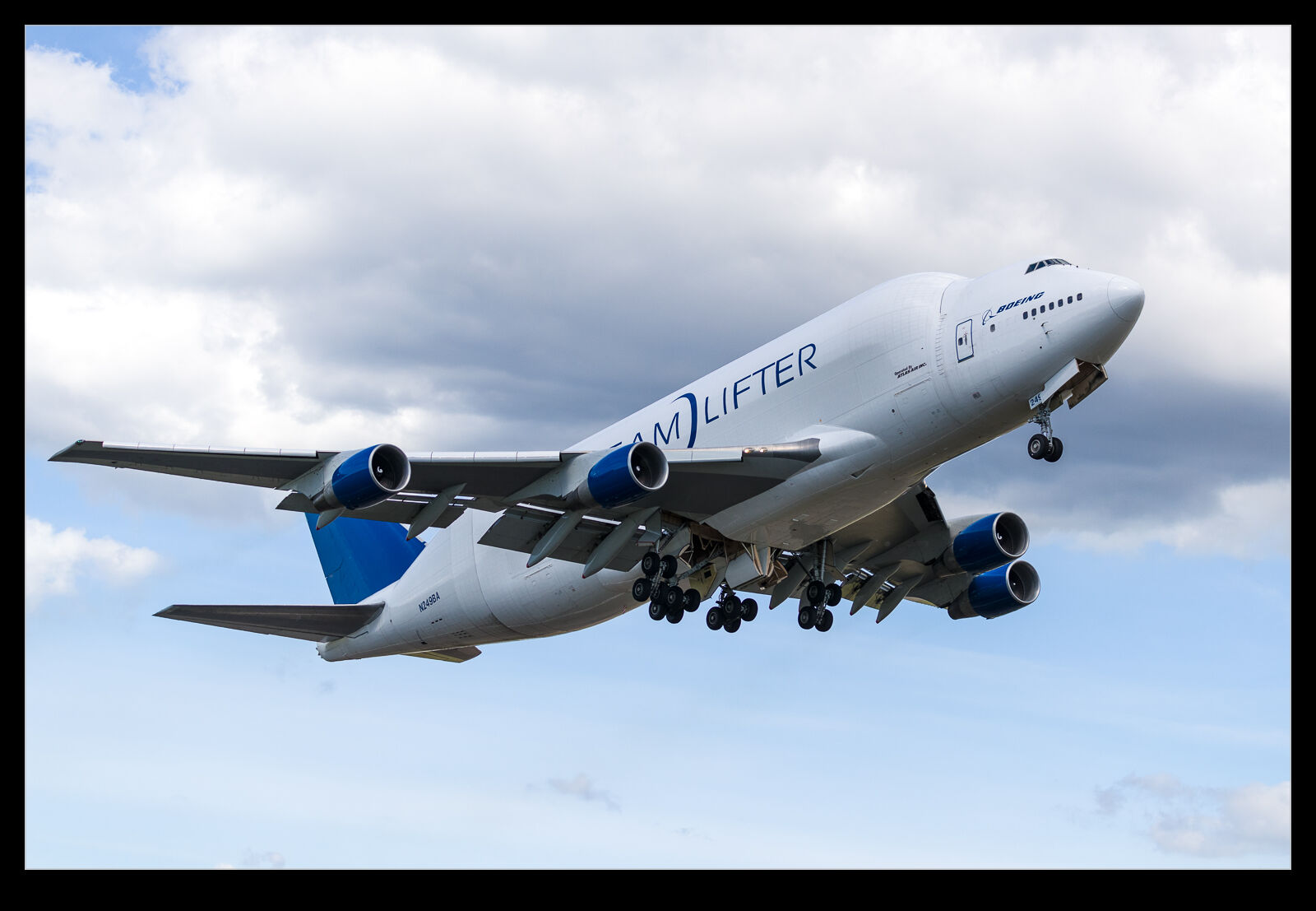 A convenient departure of a Dreamlifter from Everett meant I could get up there to see it go. The day was very nice so I was optimistic of getting a reasonable shot of it. I saw it taxi out at the far end of the field (that extra tall fin the 400LCF has makes it easy to see over the ridges in the field) and it turned towards me and accelerated.
A convenient departure of a Dreamlifter from Everett meant I could get up there to see it go. The day was very nice so I was optimistic of getting a reasonable shot of it. I saw it taxi out at the far end of the field (that extra tall fin the 400LCF has makes it easy to see over the ridges in the field) and it turned towards me and accelerated.
 The light was shining off the fuselage and it rotated as it came over the ridge towards me. Just as it got airborne and into a nice position, it found the one shadow that was anywhere in Snohomish county at that point. It isn’t awful but it was pretty bloody disappointing. As it climbed away, back into the sun of course!
The light was shining off the fuselage and it rotated as it came over the ridge towards me. Just as it got airborne and into a nice position, it found the one shadow that was anywhere in Snohomish county at that point. It isn’t awful but it was pretty bloody disappointing. As it climbed away, back into the sun of course!
Has the Catfish Escaped Me? NO!
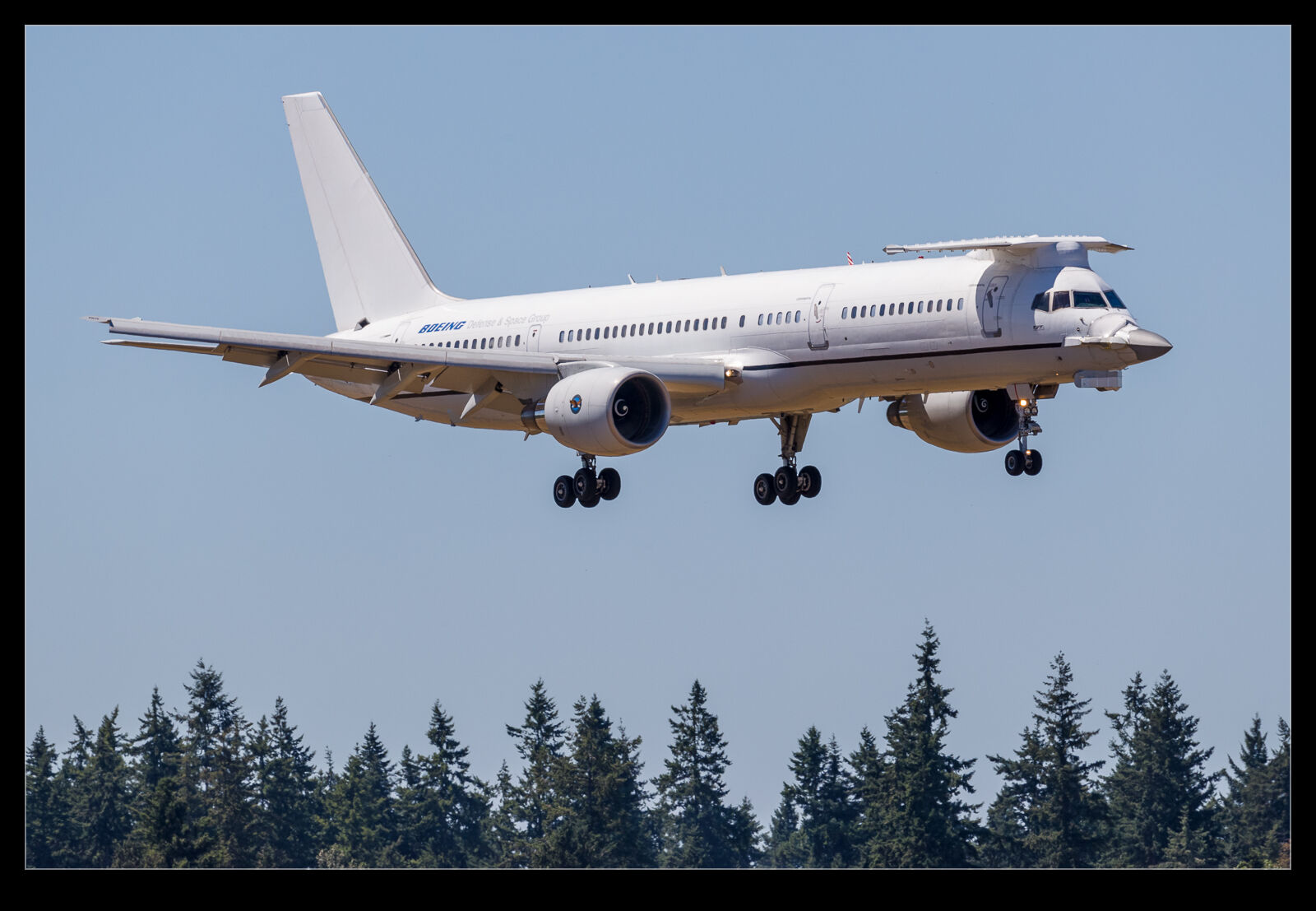 The first Boeing 757 built was kept by Boeing as a test aircraft and never went to an airline. When Boeing became a partner in the F-22 Raptor program, a new use was found for the aircraft. It was fitted out as a flying testbed for the avionics suite. A test crew could ride in the cabin and they could try out a number of different configurations of software changing things as they go without having to have the software flight qualified.
The first Boeing 757 built was kept by Boeing as a test aircraft and never went to an airline. When Boeing became a partner in the F-22 Raptor program, a new use was found for the aircraft. It was fitted out as a flying testbed for the avionics suite. A test crew could ride in the cabin and they could try out a number of different configurations of software changing things as they go without having to have the software flight qualified.
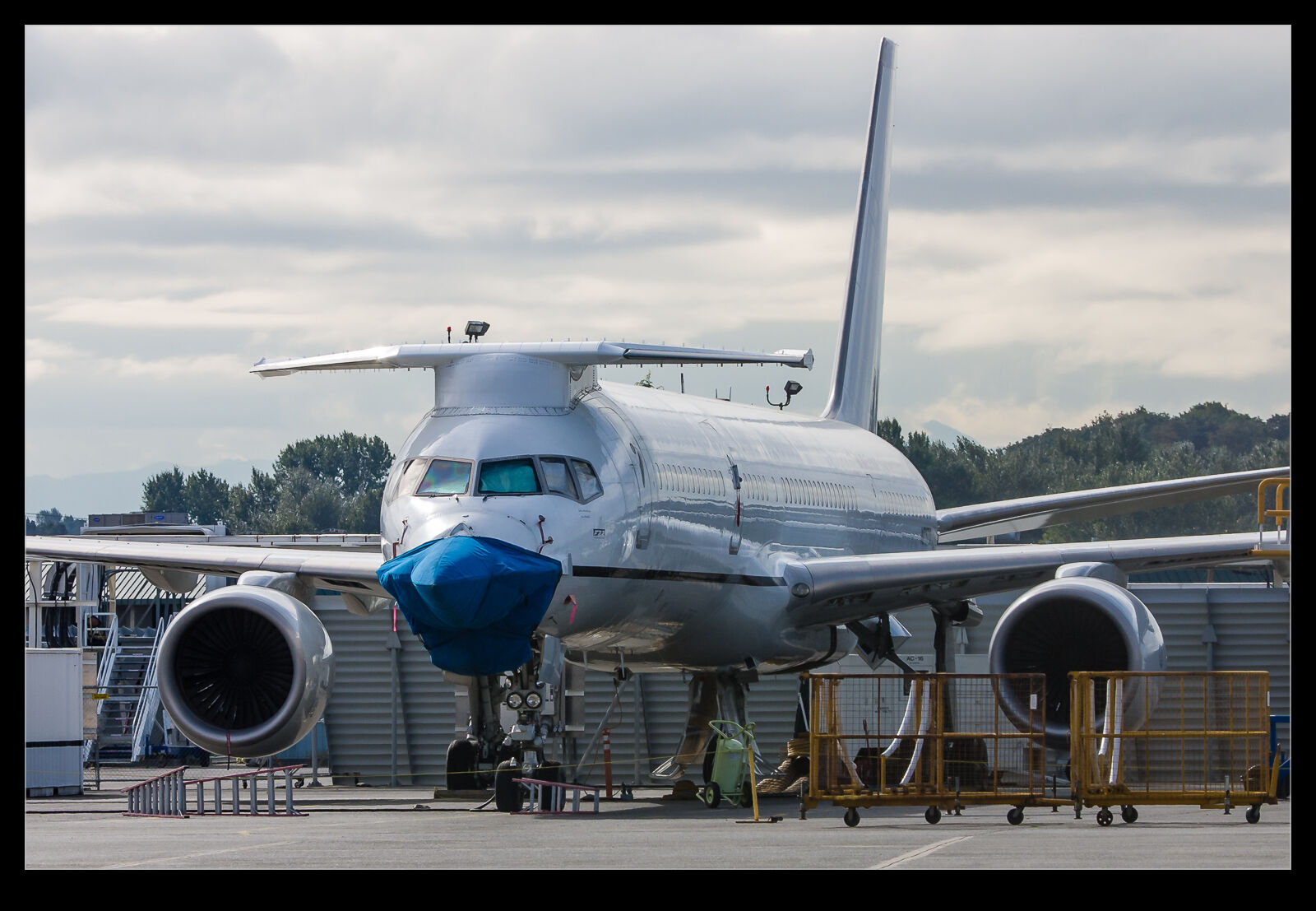 To make the whole ensemble work appropriately, the aircraft was fitted with F-22 sensors. This included a radome on the aircraft nose with the F-22’s radar. In addition, because a number of sensors were embedded in the wings, a wing structure was added about the cockpit. This unusual configuration resulted in the aircraft gaining the nickname “Catfish”. It flew a lot during the development program but I only ever saw it on the ground at Boeing Field and then it was partially obscured. I did also look down on it from an airliner approaching SeaTac.
To make the whole ensemble work appropriately, the aircraft was fitted with F-22 sensors. This included a radome on the aircraft nose with the F-22’s radar. In addition, because a number of sensors were embedded in the wings, a wing structure was added about the cockpit. This unusual configuration resulted in the aircraft gaining the nickname “Catfish”. It flew a lot during the development program but I only ever saw it on the ground at Boeing Field and then it was partially obscured. I did also look down on it from an airliner approaching SeaTac.
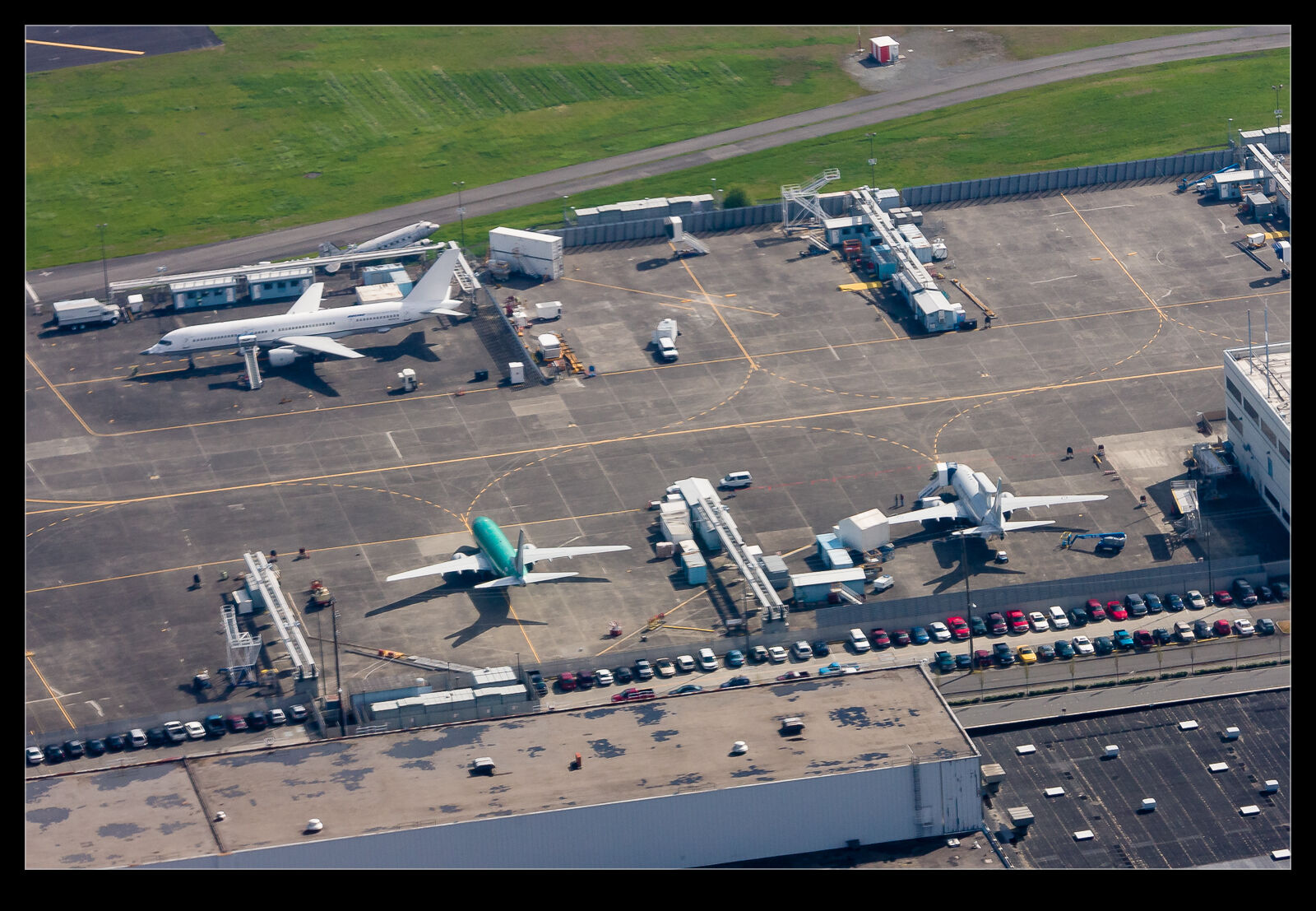 I knew it didn’t fly often but I hoped that, in moving to the area, I would finally get to see it airborne. Then I discovered that it had flown to St Louis. The rumor was that it had been retired. Indeed, on a flight across the country involving a plane change in St Louis, I did see it parked up in an open-ended hangar. I figured that might be as close as I got. Then I got a notification that it was heading west again. Better yet, it wasn’t going direct to Boeing Field but to Everett first. It is a short drive from the office to Everett and the flight plan meant it was coming in during lunch.
I knew it didn’t fly often but I hoped that, in moving to the area, I would finally get to see it airborne. Then I discovered that it had flown to St Louis. The rumor was that it had been retired. Indeed, on a flight across the country involving a plane change in St Louis, I did see it parked up in an open-ended hangar. I figured that might be as close as I got. Then I got a notification that it was heading west again. Better yet, it wasn’t going direct to Boeing Field but to Everett first. It is a short drive from the office to Everett and the flight plan meant it was coming in during lunch.
 The harsh lunchtime light and the prospect of heat haze notwithstanding, I figured this was too good a chance to miss. It showed up pretty much when expected so I was able to get some shots of it coming down the approach and across the threshold. The heat haze was really bad as it was over the runway but actually slightly less of an issue further out. I don’t care. I finally got to see it fly and that is what I was after. It headed back to St Louis from Boeing Field the following day. I have no idea when it left Everett for Boeing Field though. If it comes back again and I can see it, that will be a bonus.
The harsh lunchtime light and the prospect of heat haze notwithstanding, I figured this was too good a chance to miss. It showed up pretty much when expected so I was able to get some shots of it coming down the approach and across the threshold. The heat haze was really bad as it was over the runway but actually slightly less of an issue further out. I don’t care. I finally got to see it fly and that is what I was after. It headed back to St Louis from Boeing Field the following day. I have no idea when it left Everett for Boeing Field though. If it comes back again and I can see it, that will be a bonus.
Zero G and, Ironically, It’s Not Raining
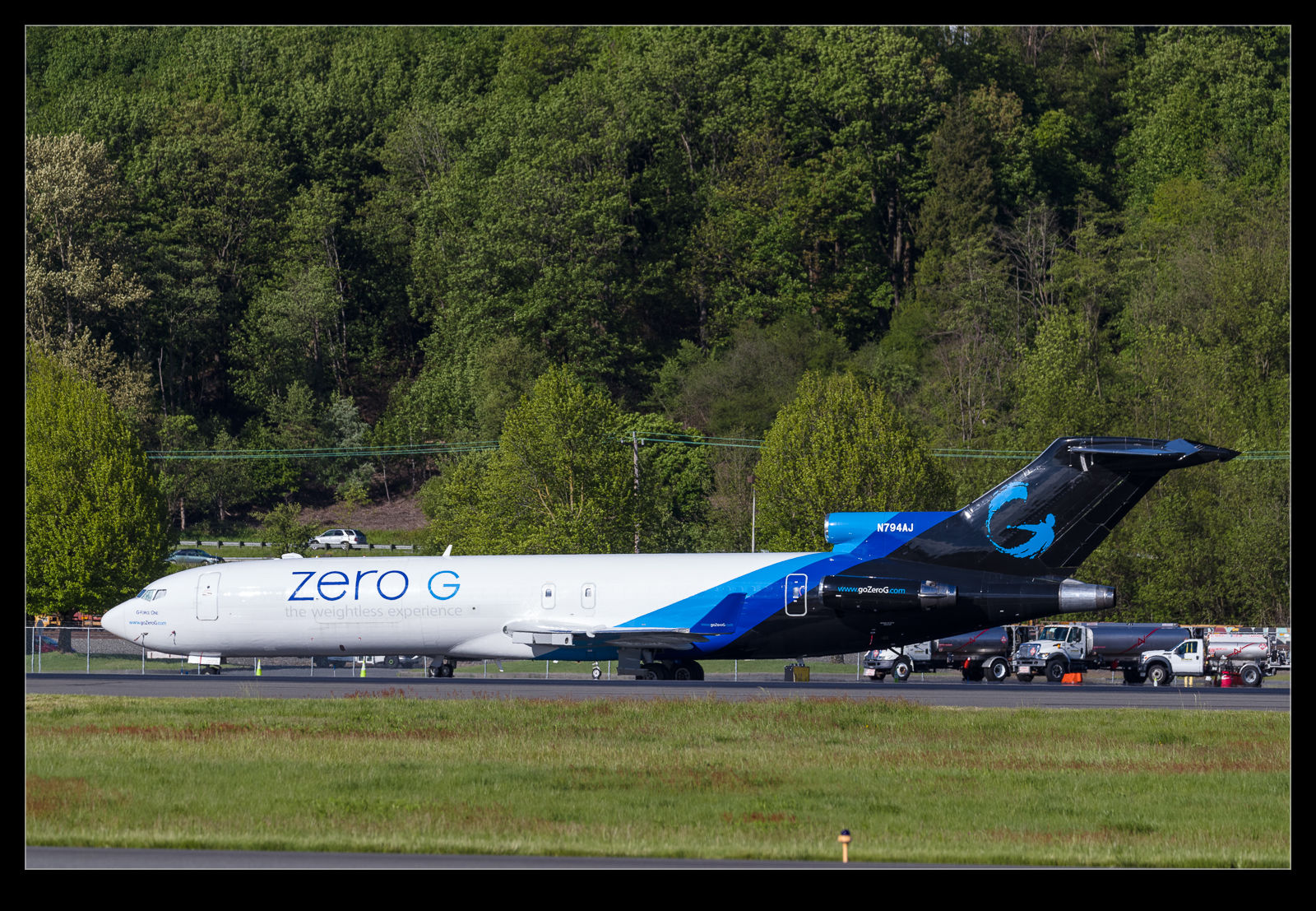 I last saw this jet on approach to Oakland. I blogged about that event here. On that day, it was pouring with rain. I got the shot but it was rather dreary. This time I saw the jet parked up at Boeing Field in Seattle. Ironically, the sun was out on a lovely day – not Seattle’s reputation. Sadly, it wasn’t moving while I was there. I don’t know why it was in town but I heard there was a big software conference underway so maybe it was a fun trip for some big cheeses in the software business.
I last saw this jet on approach to Oakland. I blogged about that event here. On that day, it was pouring with rain. I got the shot but it was rather dreary. This time I saw the jet parked up at Boeing Field in Seattle. Ironically, the sun was out on a lovely day – not Seattle’s reputation. Sadly, it wasn’t moving while I was there. I don’t know why it was in town but I heard there was a big software conference underway so maybe it was a fun trip for some big cheeses in the software business.
Honeywell Test Convair
Unloading the Wings
 The wings for the Boeing 787 Dreamliner are not built in the US. They come from Japan and they make the journey in the 747-400LCF Dreamlifter. The process for unloading them is very well practiced. The aircraft lands and is parked up. The tail is then swung open to expose the cavernous hold. A transporter pulls up behind the lane and elevates its deck to level with the aircraft. The wings are in a cradle that then slides out of the plane and on to the transporter. It then backs away and lowers down before driving the wings into a storage building.
The wings for the Boeing 787 Dreamliner are not built in the US. They come from Japan and they make the journey in the 747-400LCF Dreamlifter. The process for unloading them is very well practiced. The aircraft lands and is parked up. The tail is then swung open to expose the cavernous hold. A transporter pulls up behind the lane and elevates its deck to level with the aircraft. The wings are in a cradle that then slides out of the plane and on to the transporter. It then backs away and lowers down before driving the wings into a storage building.
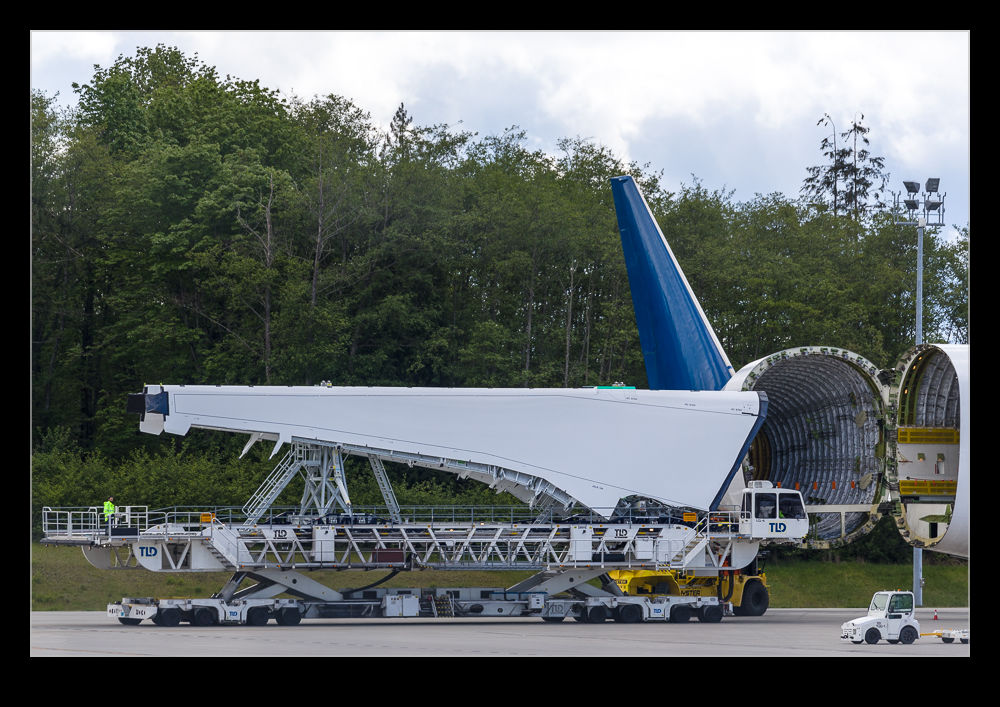 While this was going on, other fuselage parts could be seen inside. With production running at a high rate, this process is repeated every few days. I have never yet seen the Belugas at work for Airbus doing the same sort of thing but I would like to some day. Their new aircraft are currently being assembled so they will soon have more capacity. I don’t know whether Boeing will need more of the Dreamlifters at some point but the current fleet seems to be kept busy.
While this was going on, other fuselage parts could be seen inside. With production running at a high rate, this process is repeated every few days. I have never yet seen the Belugas at work for Airbus doing the same sort of thing but I would like to some day. Their new aircraft are currently being assembled so they will soon have more capacity. I don’t know whether Boeing will need more of the Dreamlifters at some point but the current fleet seems to be kept busy.
Zoomify the Boeing Flightline
Everett is a busy production facility. 787s are being built at a fair rate while 777 production continues, albeit at a reducing pace. There are some 747s and 767s coming out as well. The flightline for their testing is consequently rather full. I figured a panorama was a good idea but they are hard to put on the blog without making them too small. Time for zoomify again. You can pan around and zoom in to see what was on the line this day.
Southwest Scimitars and the Inaccuracy of Online Truths
 Online forums can be a great source of information. They can also be full of rubbish. With the introduction of the split scimitar tips on the 737 fleets, Southwest was an early adopter on their 800 series jets. However, I read that they had not been happy with performance and had stopped adopting them. They definitely weren’t going to have them on the 700 series. Above is a 700 series with split scimitars. A number of airframes have now been fitted including this one so I guess those people were not the most accurate source of info!
Online forums can be a great source of information. They can also be full of rubbish. With the introduction of the split scimitar tips on the 737 fleets, Southwest was an early adopter on their 800 series jets. However, I read that they had not been happy with performance and had stopped adopting them. They definitely weren’t going to have them on the 700 series. Above is a 700 series with split scimitars. A number of airframes have now been fitted including this one so I guess those people were not the most accurate source of info!
